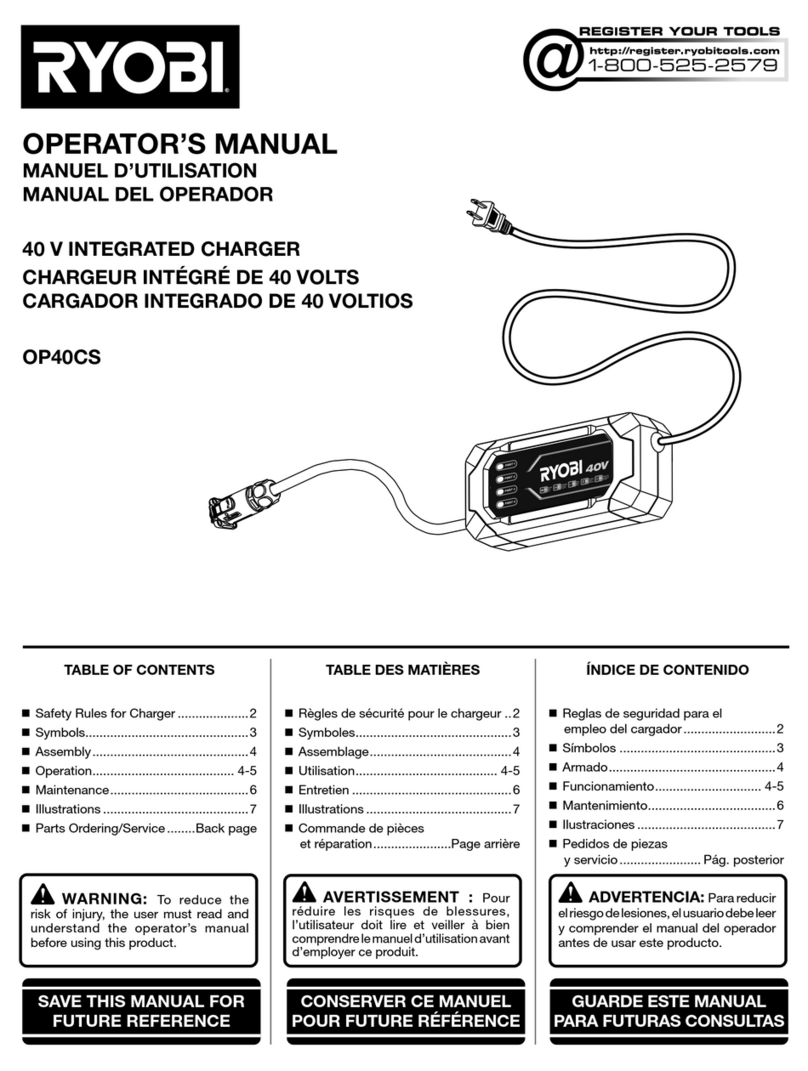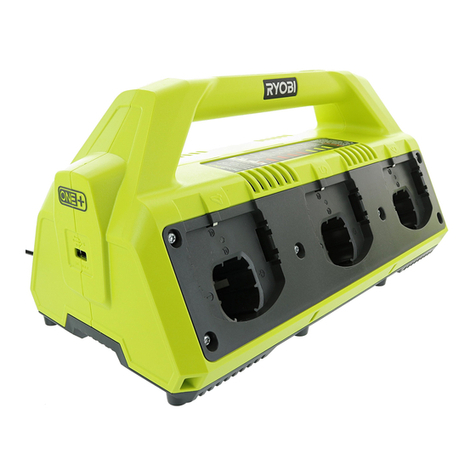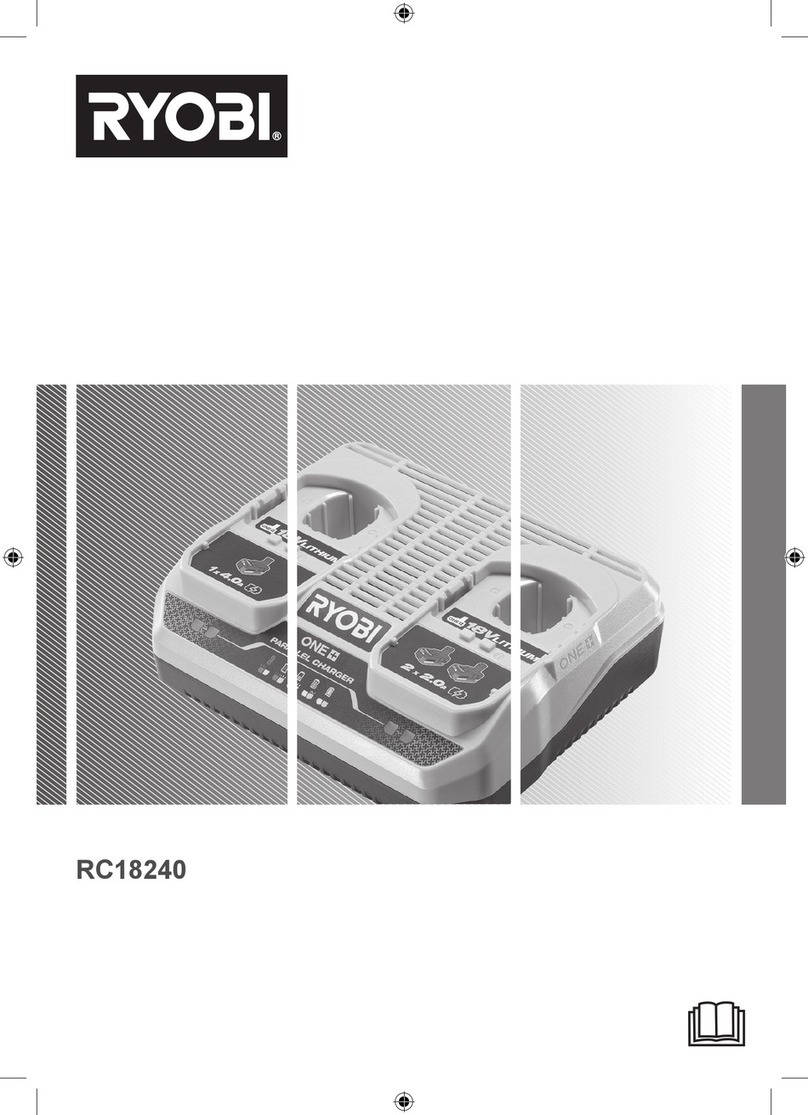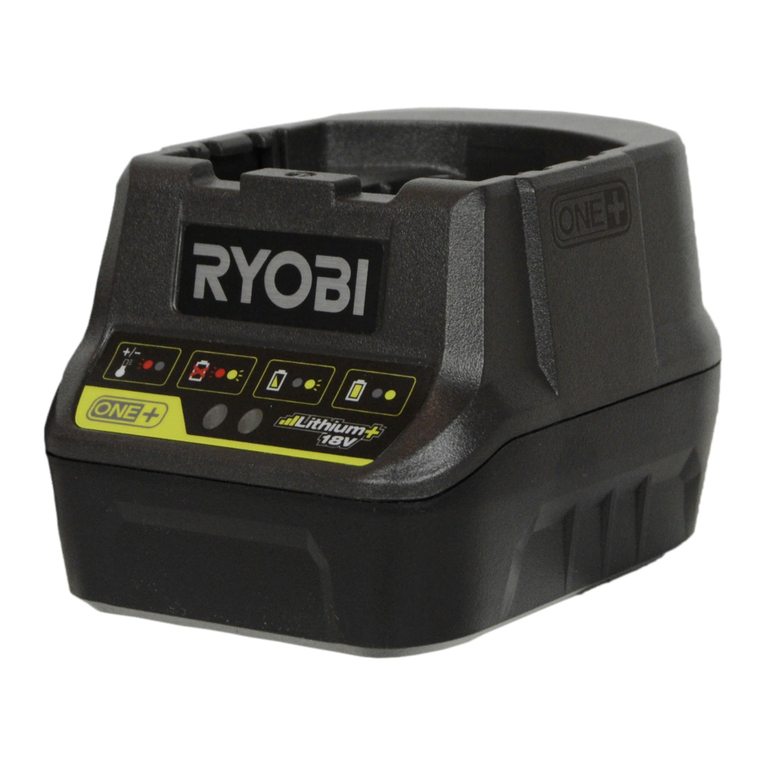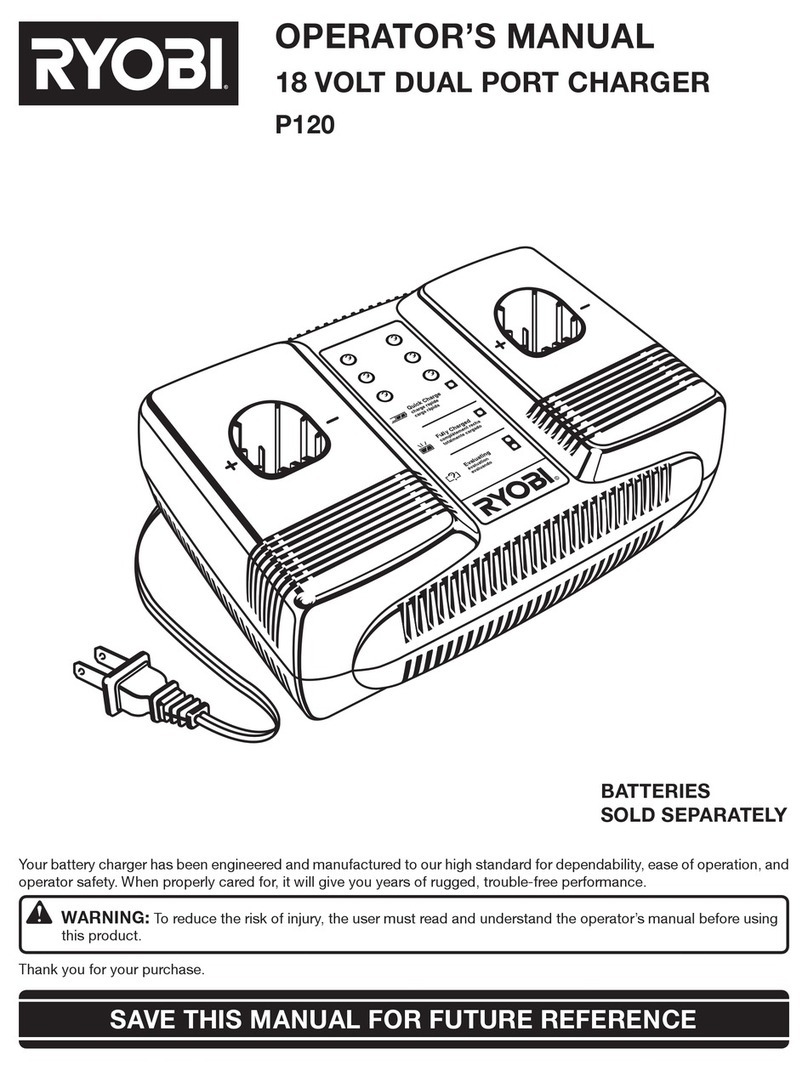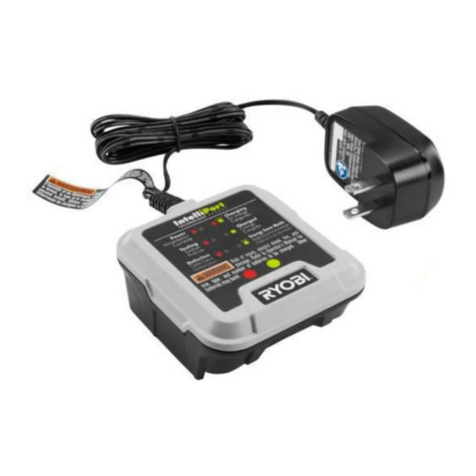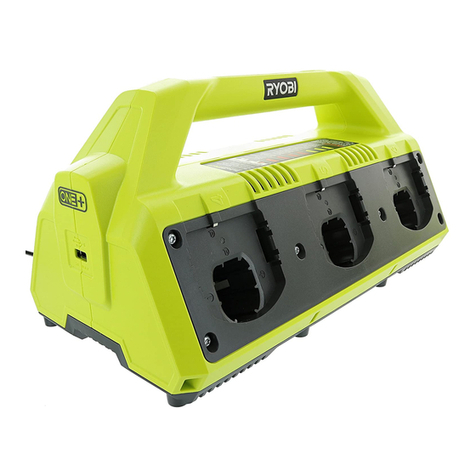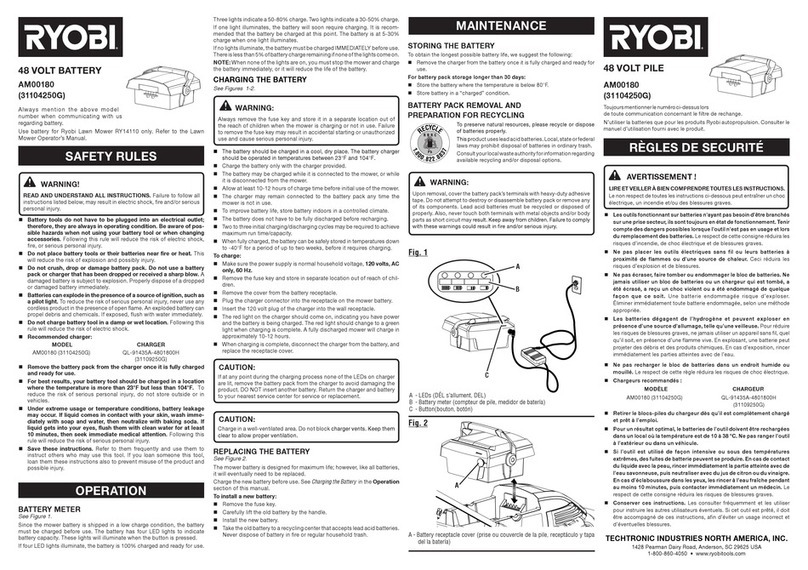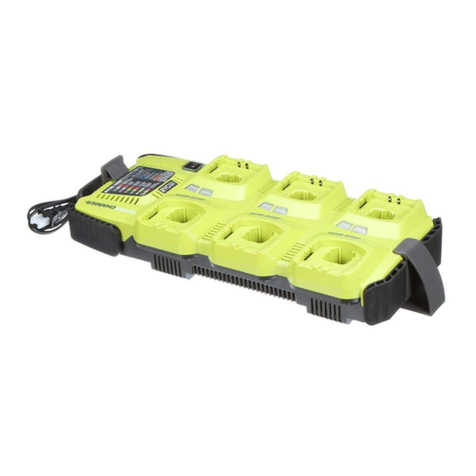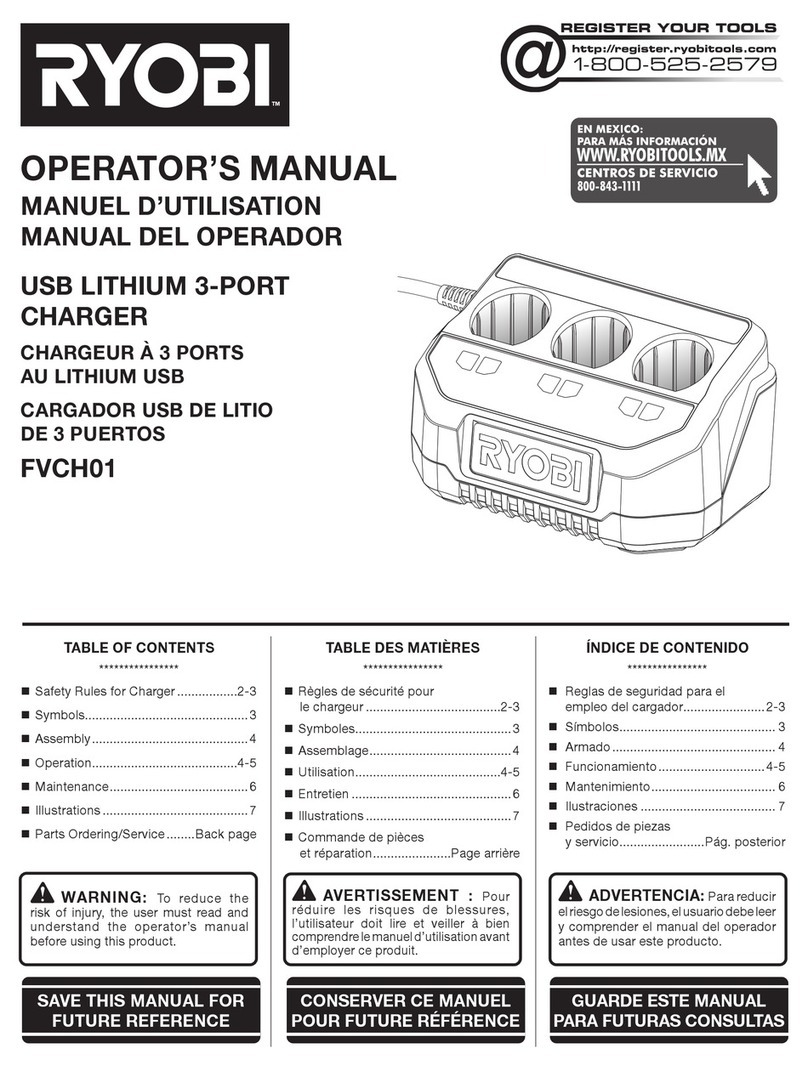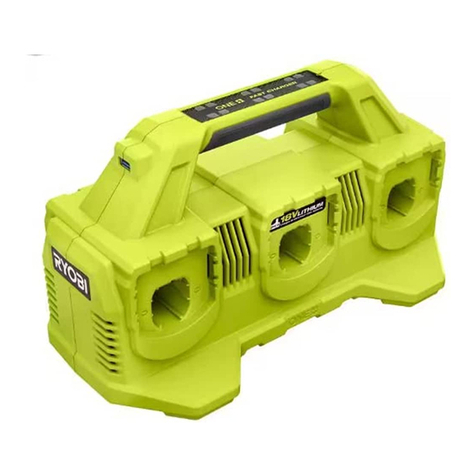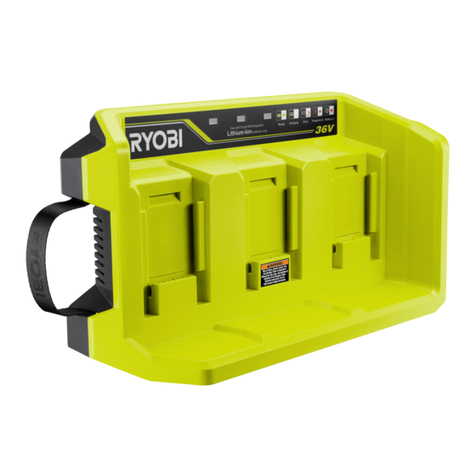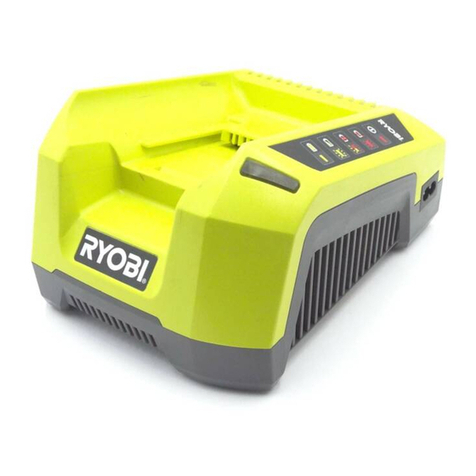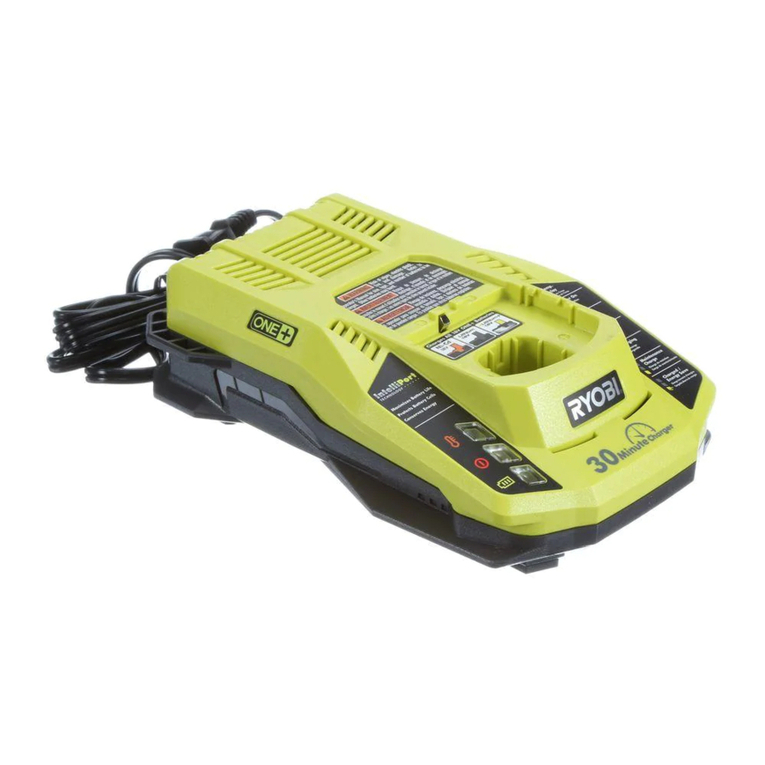Ryobi R36CHADP60 User manual

FRONT PAGE
R36CHADP60

2
Original Instructions
IMPORTANT!
The product is not intended to be used or cleaned by
persons with reduced physical, sensory, or mental
capabilities, or lack of experience or knowledge, unless
they have been given instructions concerning the safe
use of the product by a person legally responsible for
their safety. They should be supervised while using the
product. Children shall not use, clean, or play with the
product, which when not in use, should be secured out
of their reach.
It is essential that you read the instructions in this manual
before assembling, operating, and maintaining the
product.
Subject to technical modication.
Safety, performance, and dependability have been given top
priority in the design of your battery charger.
INTENDED USE
The charger is intended only to charge the compatible
battery packs listed in this manual.
The product is for indoor use only in dry conditions.
The product is not intended to charge any other type of
battery or be used as a power supply. It should never be
used in explosive or inammable environments.
Do not use the product for any other purpose.
CHARGER SAFETY WARNINGS
■Read all safety warnings and all instructions. Failure
to follow the warnings and instructions may result in
electric shock, fire, and/or serious injury.
■Do not recharge primary cells (non-rechargeable).
■The product must not be damp and should never be
used in a damp environment.
■The product is for indoor use only.
■Do not cover any ventilation slots, and provide adequate
ventilation during operation.
■Mains voltage must correspond with the voltage
specifications on the product.
■Before using the product, check that the charger
enclosure, cable, and plug are not damaged. If damage
is found, do not use the product and bring it to an
authorised service centre for repair.
■Do not use the product if it has suffered any heavy shock
or jolting, or if it is damaged in any other way.
■When charging, do not expose the product to sunlight
or other heat source. The recommended temperature
range at charging vicinity is 10° to 25°C.
■Due to the heat generated during charging, do not use
the product on a combustible surface.
■Do not use the product near flammable materials,
such as cloth, packaging materials, paint, spray paint
or aerosols, lubricants, thinners, petrol containers, gas
containers, or gas appliances.
■Never modify, disassemble, or attempt to repair the
product yourself.
■Do not allow the charger or battery packs to become
contaminated with any material that could be conductive,
such as metallic particles from grinding, cutting, or
machining processes.
■Protect the battery contact terminals from metallic
objects to avoid a short circuit, which can cause fire or
explosion.
■Unplug the product from the power socket when it is not
in use or when cleaning it.
■Use only an extension cable that is approved and in
good condition.
■Do not charge battery packs that show signs of leaks.
Dispose of them properly.
■Never charge a damaged battery pack. Replace
damaged battery packs immediately.
■Before every use, examine the supply cord for damage.
If there are signs of damage, it must be replaced by a
qualified person at an authorised service centre to avoid
a hazard.
ADDITIONAL BATTERY SAFETY WARNINGS
To reduce the risk of re, personal injury, and product
damage due to a short circuit, never immerse the tool,
battery pack, or charger in uid or allow uid to ow inside
them. Corrosive or conductive uids, such as seawater,
certain industrial chemicals, and bleach or bleach-containing
products, etc., can cause a short circuit.
WALL MOUNTING
See fig. 4
■Carefully select a stable wall for mounting the charger.
Make sure that there is no hindrance to mounting work
or operation. The maximum gross weight of the charger
is approximately 7.2 kg, provide sufficient reinforcement
for the wall if necessary.
■Mount the charger in a horizontal orientation only. Install
two screws on the wall to mount the charger. Otherwise,
the charger may fall and cause serious injury.
■Check the tightness of the screws on a regular basis.
Make sure that the head of the screws fit properly in
the wall mounting holes to hold the charger firmly in
place. Otherwise, the charger may fall because of loose
screws.
OPERATION
CHARGING THE BATTERY PACK
■Battery packs are shipped in a low charge condition.
Therefore, you should charge them before first use.
If the charger does not charge the battery pack under
normal circumstances, bring both the battery pack and
charger to an authorised service centre.
■Make sure that the power supply is normal household
voltage, 220–240 V, 50 Hz, AC only.
■Make sure that the battery pack latch clicks into place
and that the battery pack is secured in the charger
before charging.
NOTE: When the battery becomes fully charged, the green
LED remains on for 10 minutes. It is normal for the battery
pack to become slightly warm to touch while charging.
■Do not place the charger and battery pack in an area of
extreme heat or cold. They work best at normal room
temperature.
NOTE: When charging, the charger and battery pack should
be placed in a location where the temperature is more than
10°C but less than 25°C.

3
Original Instructions
CHARGING A COOL BATTERY PACK
See fig. 2
1. Align the raised rib on the battery pack with the groove in
the product, and slide in the battery pack. Make sure that
the battery pack latch clicks into place.
2. Connect the product to a power supply.
See fig. 3
1. Disconnect the product from the power supply when the
battery pack becomes fully charged.
2. Press the battery pack latch to unlock the battery pack
from the product.
3. Slide the battery pack off the product.
CHARGING A HOT BATTERY PACK
When using a tool continuously, the cells in the battery pack
become hot. A hot battery pack should be allowed to cool
down for approximately 30 minutes before recharging.
MAINTENANCE
■When not using or when cleaning the product, disconnect
it from the power supply and remove the battery pack.
■Avoid using solvents when cleaning plastic parts. Most
plastics are susceptible to various types of commercial
solvents. Use a clean cloth or a soft brush to remove
dirt and dust.
■Do not, at any time, let brake fluids, gasoline, petroleum-
based products, and penetrating oils come in contact
with plastic parts. These products contain chemicals that
can damage, weaken, or destroy plastic.
■Hazardous voltages are present within the product; do
not disassemble.
CLEANING THE CHARGER
■Unplug the charger power cord from power supply
before cleaning to prevent serious personal injury.
■Clean the charger surface (except labels) using a damp
cloth with a mild detergent.
■Do not use any strong detergents on the plastic housing.
They can be damaged by certain aromatic oils, such as
pine and lemon, and by solvents such as kerosene.
■Moisture can cause a shock hazard. Wipe off any
moisture with a soft dry cloth.
STORAGE
Store the product in a cool, dry place between 10°C and
38°C.
SYMBOLS ON THE PRODUCT
Class II: Protection against electric
shock rely on double insulation or
reinforced insulation.
Regulatory Compliance Mark (RCM).
The product meets applicable
regulatory requirements.
Indoor use only
Time-lag type fuse
To reduce the risk of injury, user
must read and understand operator's
manual before using this product.
Waste electrical products should not
be disposed of with household waste.
Please recycle where facilities exist.
Check with your local authority or
retailer for recycling advice.
SYMBOLS IN THIS MANUAL
Parts or accessories sold separately
Note
Warning
Connect to power outlet.
Disconnect to power outlet.
PRODUCT SPECIFICATIONS
Charger R36CHADP60
Weight 1.9 kg
Weight with heaviest
battery pack 7.2 kg
Voltage 36 V d.c.
Charger input 220-240 V AC,
50 Hz
Input power 590 W max
Charger output current 6 A max

4
Original Instructions
COMPATIBLE BATTERY PACKS
Battery pack Voltage Charger input Battery type Battery capacity No. of cells for
battery
Approximate
charging time
R36BTY2
BPL3620D
36 V d.c.
220-240 V AC,
50 Hz
4.2 A max
Lithium-ion
2.0 Ah 10 36 mins
R36BTY4
BPL3640D2 4.0 Ah 20 48 mins
R36BTY5
BPL3650D2 5.0 Ah 20 55 mins
R36BTY6
BPL3660D 6.0 Ah 30 70 mins
R36BTY8 8.0 Ah 20 85 mins
R36BTY12
BPL3612D 12.0 Ah 30 120 mins
CHARGER LED FUNCTIONS
Charger
status
Battery pack
inserted Battery pack Red LED Green LED Charger label
status Action
Idle No -On (5 minutes) O N/A -
Standby Yes -On O Battery in Ready to charge battery pack
Evaluation Yes
Hot On On
Testing
Fast charging begins when the battery pack
cools down.
Cold On On Fast charging begins when the battery pack
warms up.
Charging Yes
Fast charging
O Flash Charging
-
Deeply
discharged
Charger pre-charges battery until normal
voltage is reached, then begins fast charging
mode.
Defective
Yes Yes Flash Flash Error Battery temperature, battery capacity, or
charger may be faulty.
●If the LED status shows defective, reset the charger or reinsert the battery.
●If the LED status repeats a second time, try charging a different battery.
●If a different battery charges normally, dispose of the defective pack (see maintenance section).
Fully charged Yes - O On (10
minutes) Ready Fast charging is complete; charger maintains
charge mode.

5
Battery port
LED
indicator
Power cord
Wall mounting
holes
2
1
Fig.1
Fig.2

6
3
1
2
6 mm
101.77mm
114 mm
Fig.3
Fig.4

7
20220728v1

BACK PAGE
Imported by:
Techtronic Industries Australia Pty Ltd
31 Gilby Road, Mount Waverley, VIC 3149
Melbourne, Australia
Techtronic Industries N.Z. Limited
Unit C, 70 Business Parade South,
Highbrook, Auckland 2013, New Zealand
RYOBI is a trade mark of Ryobi Limited, and is used under license.
960324024-01
Table of contents
Other Ryobi Batteries Charger manuals

